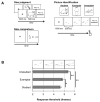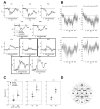The temporal dynamics of visual object priming
- PMID: 25164991
- PMCID: PMC4252596
- DOI: 10.1016/j.bandc.2014.07.009
The temporal dynamics of visual object priming
Abstract
Priming reflects an important means of learning that is mediated by implicit memory. Importantly, priming occurs for previously viewed objects (item-specific priming) and their category relatives (category-wide priming). Two distinct neural mechanisms are known to mediate priming, including the sharpening of a neural object representation and the retrieval of stimulus-response mappings. Here, we investigated whether the relationship between these neural mechanisms could help explain why item-specific priming generates faster responses than category-wide priming. Participants studied pictures of everyday objects, and then performed a difficult picture identification task while we recorded event-related potentials (ERP). The identification task gradually revealed random line segments of previously viewed items (Studied), category exemplars of previously viewed items (Exemplar), and items that were not previously viewed (Unstudied). Studied items were identified sooner than Unstudied items, showing evidence of item-specific priming, and importantly Exemplar items were also identified sooner than Unstudied items, showing evidence of category-wide priming. Early activity showed sustained neural suppression of parietal activity for both types of priming. However, these neural suppression effects may have stemmed from distinct processes because while category-wide neural suppression was correlated with priming behavior, item-specific neural suppression was not. Late activity, examined with response-locked ERPs, showed additional processes related to item-specific priming including neural suppression in occipital areas and parietal activity that was correlated with behavior. Together, we conclude that item-specific and category-wide priming are mediated by separate, parallel neural mechanisms in the context of the current paradigm. Temporal differences in behavior are determined by the timecourses of these distinct processes.
Keywords: Event-related potentials; Implicit memory; Neural suppression; Priming.
Copyright © 2014 Elsevier Inc. All rights reserved.
Figures




References
-
- Cave CB, Bost PR, Cobb RE. Effects of color and pattern on implicit and explicit picture memory. Journal of Experimental Psychology: Learning, Memory, and Cognition. 1996;22(3):639. - PubMed
Publication types
MeSH terms
Grants and funding
LinkOut - more resources
Full Text Sources
Other Literature Sources
Medical

